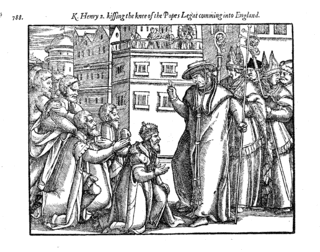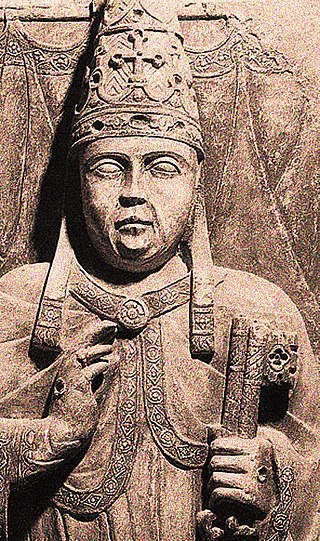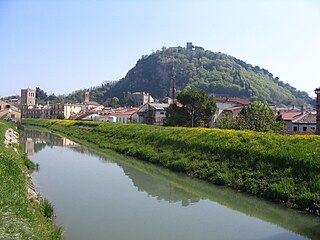
Pope Boniface VIII was the head of the Catholic Church and ruler of the Papal States from 24 December 1294 until his death in 1303. The Caetani family was of baronial origin, with connections to the papacy. He succeeded Pope Celestine V, who had abdicated from the papal throne. Boniface spent his early career abroad in diplomatic roles.

The Dark Ages is a term for the Early Middle Ages, or occasionally the entire Middle Ages, in Western Europe after the fall of the Western Roman Empire, which characterises it as marked by economic, intellectual, and cultural decline.

Cesare Baronio, C.O. was an Italian Oratorian, cardinal and historian of the Catholic Church. His best-known works are his Annales Ecclesiastici, which appeared in 12 folio volumes (1588–1607). He is under consideration for sainthood and, in 1745, Pope Benedict XIV declared him "Venerable."

The Donation of Constantine is a forged Roman imperial decree by which the 4th-century emperor Constantine the Great supposedly transferred authority over Rome and the western part of the Roman Empire to the Pope. Composed probably in the 9th century, it was used, especially in the 13th century, in support of claims of political authority by the papacy.
Pope Donus was the bishop of Rome from 676 to his death. Few details survive about him or his achievements beyond what is recorded in the Liber Pontificalis.

A papal legate or apostolic legate is a personal representative of the Pope to foreign nations, to some other part of the Catholic Church, or representatives of the state or monarchy. He is empowered on matters of Catholic faith and for the settlement of ecclesiastical matters.

Saeculum obscurum, also known as the Pornocracy or the Rule of the Harlots, was a period in the history of the papacy during the first two thirds of the 10th century, following the chaos after the death of Pope Formosus in 896 which saw seven or eight papal elections in as many years. It began with the installation of Pope Sergius III in 904 and lasted for 60 years until the death of Pope John XII in 964. During this period, the popes were influenced strongly by a powerful and allegedly corrupt aristocratic family, the Theophylacti, and their relatives and allies. The era is seen as one of the lowest points of the history of the papal office.

Ippolito de' Medici was the only son of Giuliano di Lorenzo de' Medici, born out of wedlock to his mistress Pacifica Brandano.
Aulus Pudens was a native of Umbria and a centurion in the Roman army in the late 1st century. He was a friend of the poet Martial, who addressed several of his Epigrams to him. He has been identified by some with Saint Pudens, an early Roman Christian.
Odorico Raynaldi or Rinaldi, also known as Raynald, was an Italian historian and Oratorian.

Abraham Bzowski (Bzovius) (1567–1637) was a Polish Dominican historian. He carried on the work of Baronius. The Catholic Encyclopedia calls his contributions for 1198 to 1571 "less notable" than some of other continuators, namely Raynaldus, Laderchi, and August Theiner.

Antoine Pagi was a French ecclesiastical historian.

The 1431 papal conclave convened after the death of Pope Martin V and elected as his successor Cardinal Gabriele Condulmer, who took the name Eugene IV. It was the first papal conclave held after the end of the Great Western Schism.

Pierre Desprès (1288–1361) was a French Cardinal during the period of the Avignon Papacy.

Francesco Panigarola was an Italian Franciscan preacher and controversialist, and Bishop of Asti.
François Pagi was a French Franciscan historian of the Catholic Church.
Ottaviano di Poli, a member of the family of the Counts of Poli, was an Italian Roman Catholic Cardinal.

The papal conclave held from 13 to 20 December 1334 elected Jacques Fournier to succeed John XXII as pope. Fournier took the name Benedict XII.

In the 1303 papal conclave, Benedict XI was elected to succeed Boniface VIII as pope.

Simone Paltanieri, son of Pesce Paltanieri, member of a distinguished family, was an Italian Roman Catholic cardinal.
















